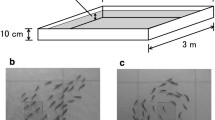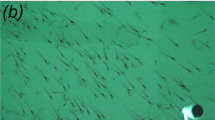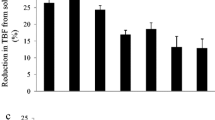Abstract
Many aquatic animals face a fundamental problem during foraging and migratory movements: while their resources commonly vary at large spatial scales, they can only sample and assess their environment at relatively small, local spatial scales. Thus, they are unable to choose movement directions by directly sampling distant parts of their environment. A common strategy to overcome this problem is taxis, a behaviour in which an animal performs a biased random walk by changing direction more rapidly when local conditions are getting worse. Such an animal spends more time moving in right directions than wrong ones, and eventually gets to a favourable area. Taxis is inefficient, however, when environmental gradients are weak or overlain by ‘noisy’ small-scale fluctuations. In this paper, I show that schooling behaviour can improve the ability of animals performing taxis to climb gradients, even under conditions when asocial taxis would be ineffective. Schooling is a social behaviour incorporating tendencies to remain close to and align with fellow members of a group. It enhances taxis because the alignment tendency produces tight angular distributions within groups, and dampens the stochastic effects of individual sampling errors. As a result, more school members orient up-gradient than in the comparable asocial case. However, overly strong schooling behaviour makes the school slow in responding to changing gradient directions. This trade-off suggests an optimal level of schooling behaviour for given spatio-temporal scales of environmental variations. Social taxis may enhance the selective value of schooling in pelagic grazers such as herrings, anchovies and Antarctic krill. Furthermore, the degree of aggregation in a population of schooling animals may affect directly the rate and direction of migration and foraging movements.
Similar content being viewed by others
References
Alt, W. (1980) Biased random walk models for chemotaxis and related diffusion approximations. J. Math. Biol. 9, 147–177.
Alt, W. (1985) Degenerate diffusion equations with drift functionals modelling aggregation. Nonlinear Analysis, Theory, Methods & Applications 9, 811–836.
Aoki, I. (1982) A simulation study on the schooling mechanism in fish. Bull. Jap. Soc. Sci. Fish. 48, 1081–1088.
Atema, J. (1988) Distribution of chemical stimuli. In Sensory Biology of Aquatic Animals (J. Atema, R.R. Fay, A.N. Popper and W.N. Tavolga, eds), pp. 29–57. Springer-Verlag, Berlin.
Baker, P.S., Gewecke, M. and Cooter, R.J. (1984) Flight orientation of swarming Locusta migratoria. Pysiol. Ent. 9, 247–252.
Clark, C.W. and Dukas, R. (1994) Balancing foraging and antipredator demands: An advantage of sociality. Am. Nat. 144, 542–548.
Daly, K.L. and Macaulay, M.C. (1991) Influence of physical and biological mesoscale dynamics on the seasonal distribution and behavior of Euphausia superba in the Antarctic marginal ice zone. Mar. Ecol. Prog. Ser. 79, 37–66.
Davis, C.S., Flierl, G.R., Wiebe, P.H. and Franks, P.J.S. (1991) Micropatchiness, turbulence, and recruitment in plankton. J. Mar. Res. 49, 1–43.
Domenici, P. and Batty, R.S. (1994) Escape manoeuvres of schooling Clupea harengus. J. Fish Biol. 45 (suppl. A), 97–110.
Edelstein-Keshet, L. (1988) Mathematical Models in Biology. Random House, New York.
Ezoe, H., Iwasa, Y. and Umeda, T. (1994) Aggregation by chemotactic random walk: Drifting clusters and chemotactic friction. J. Theor. Biol. 168, 259–267.
Foster, S.A. (1987) Acquisition of a defended resource: A benefit of group foraging for the neotropical wrasse, Thalassoma lucasanum. Env. Biol. Fish. 3, 215–222.
Grünbaum, D. (1994) Translating stochastic density-dependent individual behavior with sensory constraints to a continuum model of animal swarming. J. Math. Biol. 33, 139–161.
Grünbaum, D. and Okubo, A. (1994) Modelling social animal aggregations. In Frontiers in Theoretical Biology (S.A. Levin, ed.), pp. 296–325. Lecture Notes in Biomathematics Vol. 100. Springer-Verlag, Berlin.
Gueron, S. and Levin, S.A. (1995) The dynamics of group formation. Math. Biosci. 128, 243–264.
Hamner, W.M. (1984) Aspects of schooling in Euphausia superba. J. Crust. Biol. 4 (Spec. No. 1), 67–74.
Hamner, W.M., Hamner, P.P., Strand, S.W. and Gilmer, R.W. (1983) Behaviour of Antarctic krill, Euphausia superba: Chemoreception, feeding, schooling, and molting. Science 220, 433–435.
Haney, J.C., Fristrup, K.M. and Lee, D.S. (1992) Geometry of visual recruitment by seabirds to ephemeral forgaging flocks. Ornis Scand. 23, 49–62.
Heppner, F. and Grenander, U. (1990) A stochastic nonlinear model for coordinated bird flocks. In The Ubiquity of Chaos (S. Krusna, ed.), pp. 233–238. AAAS Publications, Washington, DC.
Huth, A. and Wissel, C. (1990) The movement of fish schools: A simulation model. In Bilogical Motion (W. Alt and G. Hoffmann, eds), pp. 577–590. Lecture Notes in Biomathematics, Vol. 89. Springer-Verlag, Berlin.
Huth, A. and Wissel, C. (1992) The simulation of the movement of fish schools. J. Theor. Biol. 156, 365–385.
Inagaki, T., Sakamoto, W. and Kuroki, T. (1976) Studies on the schooling behaviour of fish. II: Mathematical modelling of schooling form depending on the intensity of mutual force between individuals. Bull. Jap. Soc. Sci. Fish. 42, 265–270.
Kareiva, P. and Odell, G. (1987) Swarms of predators exhibit ‘preytaxis’ if individual predators use area-restricted search. Am. Nat. 130, 207–228.
Kawasaki, K. (1978) Diffusion and the formation of spatial distribution. Math. Sci. 16, 47–52.
Keller, E.F. and Segel, L.A. (1971) Model for chemotaxis. J. Theor. Biol. 30, 225–234.
Kennedy, J.S. (1951). The migration of the desert locust (Schistocerca gregaria Forsk.). Phil. Trans. R. Soc. Lond. B 235, 163–290
Kils, U. (1981) The Swimming Behaviour, Swimming Performance and Energy Balance of Antarctic Krill, Euphausia superba. BIOMASS Scientific Series No. 3. SCAR/SCOR, Scott Polar Research Institute, Cambridge.
Kshatriya, M. and Blake, R.W. (1992) Theoretical model of the optimum flock size of birds flying in for-mation. J. Theor. Biol. 157, 135–174.
Levin, S.A., Morin, A. and Powell, T.M. (1989) Pattern and processes in the distribution and dynamics of Antarctic krill. Scientific Report VII/BG 20, 281–296. Report for the Commission for the Conservation of Antarctic Marine Living Resources (CCAMLR).
Matuda, K. and Sannomiya, N. (1980) Computer simulation of fish behaviour in relation to fishing gear. I: Mathematical model of fish behaviour. Bull. Jap. Soc. Sci. Fish. 46, 689–697.
Matuda, K. and Sannomiya, N. (1985) Computer simulation of fish behaviour in relation to a trap model. Bull. Jap. Soc. Sci. Fish. 51, 33–39.
Miller, D.G.M. and Hampton, I. (1989) Biology and Ecology of the Antarctic Krill (Euphausia superba Dana): A review. BIOMASS Scientific Series No. 9. SCAR/SCOR, Scott Polar Research Institute, Cambridge.
Monin, A.S. and Ozmidov, R.V. (1985) Turbulence in the Ocean. D. Reidel, Dordrecht.
Morgan, M.J. and Colgan, P.W. (1987) The effects of predator presence and shoal size on foraging in bluntnose minnows, Pimephales notatus. Env. Biol. Fish. 20, 105–111.
Mullen, A.J. (1989) Aggregation of fish through variable diffusivity. Fish. Bull. USA 87, 353–362.
Murray, J.D. (1989) Mathematical Biology. Springer-Verlag, Berlin.
Nihoul, J.C.J. (1981) Marine hydrodynamics at ecological scales. In Ecohydrodynamics (J.C.J. Nihoul, ed.), pp. 1–12. Elsevier, Amsterdam.
O'Brien, D.P. (1989) Analysis of the internal arrangement of individuals within crustacean aggregations (Euphausiacea, Mysidacea). J. Exp. Mar. Biol. Ecol. 128, 1–30.
Okubo, A. (1980) Diffusion and Ecological Problems: Mathematical Models. Biomathematics Vol. 10. Springer-Verlag, Berlin.
Okubo, A. (1986) Dynamical aspects of animal grouping: Swarms, schools, flocks and herds. Adv. Biophys. 22, 1–94.
Othmer, H.G., Dunbar, S.R. and Alt, W. (1988) Models of dispersal in biological systems. J. Math. Biol. 26, 263–298.
Parrish, J.K. (1992) Levels of diurnal predation on a school of flat-iron herring, Harengula thrissina. Env. Biol. Fish. 34, 257–263.
Pattiaratchi, C.B., Micallef, S., Aiken, J., Osborne, M.J., Collins, M.B. and Williams, R. (1989) Chlorophyll variation at Ocean Weather Station Lima (57 degrees N, 20 degrees W). In Reproduction, Genetics, and Distributions of Marine Organisms (J.S. Ryland and P.A. Tyler, eds), pp. 423–429. Olsen and Olsen, Fredensborg, Denmark.
Pfistner, B. and Alt, W. (1990) A two dimensional random walk model for swarming behavior. In Biological Motion (W. Alt and G. Hoffmann, eds), pp. 584–565. Lecture Notes in Biomathematics Vol. 89. Springer-Verlag, Berlin.
Pitcher, T. (1983) Heuristic definitions of shoaling behaviour. Anim. Behav. 31, 611–613.
Pitcher, T.J. (1986) Functions of shoaling behaviour in teleosts. In Behaviour of Teleost Fishes (T.J. Pitcher, ed.), pp. 294–337. Chapman & Hall, London.
Pitcher, T.J. and House, A.C. (1987) Foraging rules for group feeders: Area copying depends upon food density in shoaling goldfish. Ethology 76, 161–167.
Pitcher, T.J. and Parrish, J.K. (1993) Functions of shoaling behaviour in teleosts. In Behaviour of Teleost Fishes (T.J. Pitcher, ed.), pp. 363–469. Chapman & Hall, London.
Pitcher, T.J., Magurran, A.E. and Winfield, T.J. (1982) Fish in larger schools find food faster. Behav. Ecol. Sociobiol. 10, 149–151.
Porter, J.M. and Sealy, S.G. (1982) Dynamics of seabirds multisepecies feeding flocks: Age-related feeding behaviour. Behaviour 81, 91–109.
Powell, T.M. (1989) Physical and biological scales of variability in lakes, estuaries, and the coastal ocean. In Perspectives in Ecological Theory (J. Roughgarden, R.M. May and S.A. Levin, eds), pp. 157–177. Princeton University Press, Princeton, NJ.
Price, H.J. (1989) Swimming behaviour of krill in response to algal patches: A mesocosm study. Limnol. Oceanogr. 34, 649–659.
Priddle, J., Watkins, J., Morris, D., Rickets, C. and Buchholz, F. (1990) Variation of feeding by krill in swarms. J. Plank. Res. 12, 1189–1205.
Prins, H.H. (1989) Buffalo herd structure and its repercussions for condition of individual African buffalo cows. Ethology 81, 47–71.
Ranta, E. and Kaitala, V. (1991) School size affects individual feeding success in three-spined sticklebacks (Gasterosteus aculeatus L.). J. Fish. Biol. 39, 733–737.
Rose, G.A. and Legget, W.C. (1990) The importance of scale to predator-prey spatial correlations: An example of Atlantic fishes. Ecology 71, 33–43.
Royce, W.F. (1972) Introduction to the Fishery Sciences. Academic Press, London.
Ryer, C.H. and Olla, B.H. (1991) Information transfer and the facilitation and inhibition of feeding in a schooling fish. Env. Biol. Fish. 30, 317–323.
Schultz, S., Breuel, G., Lass, U., Matthäus, W., Nehring, D. and Postel, L. (1989). The patchy distribution of oceanological parameters during the spring bloom in the Baltic proper. In Reproduction, Genetics, and Distributions of Marine Organisms (J.S. Ryland and P.A. Tyler, eds), pp. 423–429. Olsen and Olsen, Fredensborg, Denmark.
Sinclair, A.R.E. (1977) The African Buffalo. University of Chicago Press, Chicago, IL.
Smith, M.F.L. and Warburton, K. (1992) Predator shoaling moderates the confusion effect in blue-green chromis, Chromis viridis. Behav. Ecol. Sociobiol. 30, 103–107.
Steele, C.W., Scarfe, A.D. and Owens, D.W. (1991) Effects of group size on the responsiveness of zebrafish, Brachydanio rerio (Hamilton Buchanan), to alanine, a chemical attractant. J. Fish. Biol. 38, 553–564.
Strand, S.W. and Hamner, W.M. (1990) Schooling behaviour of Antarctic krill (Euphausia superba) in lab-oratory aquaria: Reactions to chemical and visual stimuli. Mar. Biol. 106, 355–359.
Tranquillo, R.T. (1990) Models of chemical gradient sensing by cells. In Biological Motion (W. Alt and G. Hoffmann, eds), pp. 415–442. Lecture Notes in Biomathematics Vol. 89. Springer-Verlag, Berlin.
Veit, R.R., Silverman, E.D. and Everson, I. (1993) Aggregation patterns of pelagic predators and their principal prey, Antarctic krill near South Georgia. J. Anim. Ecol. 62, 551–564.
Veit, R.R., Silverman, E.D., Hewitt, R.P. and Demer, D.A. (1995) Spatial and behavioural responses by foraging seabirds to Antarctic krill swarms. Ant. J. U.S. 29, 164–166.
Waloff, Z. (1972) Observations on the airspeeds of freely flying locusts. Anim. Behav. 20, 367–372.
Warburton, K. and Lazarus, J. (1991) Tendency-distance models of social cohesion in animal groups. J. Theor. Biol. 150, 473–488.
Weber, L.H., El-Sayed, S.Z. and Hampton, I. (1986) The variance spectra of phytoplankton, krill and water temperature in the Antarctic Ocean south of Africa. Deep-Sea Res. 33, 1327–1343.
Witek, Z., Kalinowski, J., Grelowski, A. and Wolnomiejski, N. (1981) Studies of aggregations of krill (Eu-phausia superba). Meeresforsch. 28, 228–243.
Wolf, N.G. (1987) Schooling tendency and foraging benefit in the ocean surgeonfish. Behav. Ecol. Sociobiol. 21, 59–63.
Author information
Authors and Affiliations
Rights and permissions
About this article
Cite this article
GrÜnbaum, D. Schooling as a strategy for taxis in a noisy environment. Evolutionary Ecology 12, 503–522 (1998). https://doi.org/10.1023/A:1006574607845
Issue Date:
DOI: https://doi.org/10.1023/A:1006574607845




